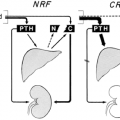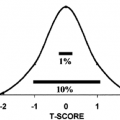ANGIOTENSIN RECEPTORS
A-II binds and acts on its receptors at the cell surface. Several receptor subtypes have been found, including the AT1, AT2, and AT454, 55 and 56
AT1Receptor Subtype.
Almost all actions of A-II are mediated through the AT1 receptor, including its effects on vasoconstriction and aldosterone production and cell growth (Fig. 79-6).The AT1 receptor is part of the superfamily of peptide hormone receptors with seven membrane-spanning regions linked to G proteins (Fig. 79-7). AT1 activates phospholipase C, which in turn hydrolyzes phosphoinositide to inositol triphosphate54 These changes increase the intracel-(IP3) and diacylglycerol. These changes increase the intracellular calcium levels that in turn activate protein kinases. Also, AT1 receptors appear to lower levels of intracellular
cAMP, an effect that is most evident in the adrenal gland on the control of aldosterone secretion.54
cAMP, an effect that is most evident in the adrenal gland on the control of aldosterone secretion.54
Stay updated, free articles. Join our Telegram channel

Full access? Get Clinical Tree






